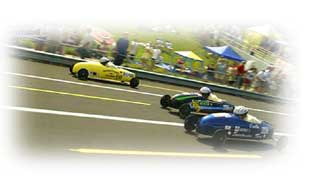FIFTY YEARS, FIFTY STATES

The range of athletic pursuits and events in the United States is extensive, something that a well-known magazine is in the process of depicting.
The weekly Sports Illustrated, America's leading sports magazine, has been celebrating its 50th anniversary by profiling some aspect of sports each week in a different one of America's 50 states.
|
The annual soap box derby, in Akron, Ohio. |
"We have had the rare privilege of documenting American sport for the past 50 years and our anniversary gives us the opportunity to celebrate the role of sports as a force for good in our country," explained Sports Illustrated president Bruce Hallett.
The series of articles began last July and will conclude in July of 2004. Taken as a whole when completed, the features will provide a comprehensive and entertaining picture of how Americans play for fun and glory. Here are gleanings of the coverage so far:
In Texas in the fall, high school football on Friday nights is legendary. As onetime college gridiron coach Fred Akers told Sports Illustrated, "the phenomenon's hard to explain, but it's in our bones." Up to 10 percent of the student body of the average secondary school participates in the school's football program.
In Maryland each August, more than 1,000 players, from their teens through their 60s, compete in the Ocean City Lacrosse Classic. Lacrosse, not widely played in many other areas of the United States, is one of the state's premier sports obsessions. "The idea is to have [kids] playing catch before they leave the delivery room," one participant, Casey Connor, observed.
Moab, Utah - a town of 4,800 that has been a popular backdrop for such Hollywood films as Forrest Gump and Thelma and Louise - draws mountain bikers from around the country for a wildly popular team-relay event each October. And the New River Gorge in rural West Virginia, known - Sports Illustrated observes - as "the West of the East," is acknowledged as one of America's most attractive areas for adventure sports fanatics - climbers, rafters, and bikers. Writing about the small community of Fayetteville, Chris Ballard said, "rock jockeys and river rats are embedded in the former coal mining town like a bolt into granite."
Virginia, absorbed by football in the fall, turns its attention each May to two prominent equestrian steeplechase events, the Virginia Gold Cup and the International Gold Cup. The state's rolling rural hills, where momentous battles were fought during the Revolutionary War and the Civil War, are familiarly known as "horse country," rich in thoroughbred stock. Steeplechase racing has been a staple of the Virginia sports scene since the 18th century.
The state of Ohio is host to what Sports Illustrated writer Frank Lidz calls "the wee world of kiddie car racing" - the All-American Soap Box Derby in the city of Akron. For a fleeting moment each year, the Derby establishes the state as "the center of the sporting universe," in Lidz's words. The event, which began during Depression-era America, brings together several hundred eight-to-17-year-old boys and girls who race down a 989-foot track in sleek, motor-less fiberglass cars that achieve, with gravity's aid, a speed of about 30 miles an hour. Contestants reach the Derby by winning local races in communities around the country, which, in the words of one 11-year-old competitor at Akron, means "we're all champs."
|
Arguably, the most riveting sporting event in the state of Pennsylvania, taking place each August, is the 65-year-old Little League World Series, a 10-day tournament that is the chief claim to fame of the town of Williamsport. Now telecast internationally, with major corporate sponsorships, it is the climactic segment of the largest sports youth program in the world. The baseball competition involves nearly three million participants in more than 100 countries, ranging in age from five to 18. On-site audiences generally total 70,000 fans, young and old.
Enhancing the excitement of the competition is the complementary benefit that Little League participants reap from the opportunity to meet and interact with peers from a wide mix of countries. "I learned a word for `hello,'" one young athlete said, "but I'm not sure if it's Chinese or Japanese!"
During the last week of July each year, Cheyenne, Wyoming, relives a century-old tradition with Frontier Days, the world's largest outdoor rodeo. More than 10,000 persons attend to watch the competition among bull and saddle bronco riders and other events. And - as is common with so many locally and regionally sponsored sports competitions in the United States - some 2,500 volunteers from Cheyenne and the surrounding area assist in organizing parades, pancake breakfasts, and cultural entertainment and in setting up a replica of a western frontier town, all to enliven the festival and provide nostalgic glimpses of the region's past.
If nothing else, the Sports Illustrated anniversary series is underscoring the rich diversity of sports and how they are celebrated in the United States. The range — from surfboard competitions in Hawaii and California to NASCAR auto racing in South Carolina and Florida — seems limitless.
If any one locale tries to bring it all together, it may be Columbia, Missouri, a college town that each summer sponsors what is known as the Show-Me State Games (Show-Me State is Missouri's nickname). Over the course of several weeks, nearly 30,000 competitors participate in some three-dozen sports that range from basketball, soccer, and track to miniature golf and ping-pong. Participants this past year included an 87-year-old bowler, a 14-year-old legally blind wrestler, and a three-year-old sprinter.
"Our mission," director Ken Ash told Sports Illustrated's Kelly King, "is getting as many Missourians as possible to participate in activities that promote health and fitness."
That sounds like a worthy goal for communities everywhere.

